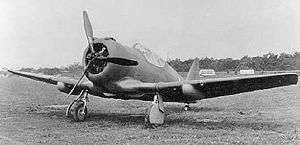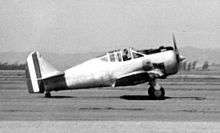North American P-64
| NA-50, NA-68/P-64 | |
|---|---|
 | |
| North American P-64 | |
| Role | Fighter |
| Manufacturer | North American Aviation |
| First flight | May 1939 (NA-50)[1] 1 September 1940 (NA-68)[2] |
| Retired | 1950 (Peru) |
| Primary users | Peruvian Air Force United States Army Air Forces |
| Number built | 13 |
| Developed from | North American NA-16 |
The North American P-64 was the designation assigned by the United States Army Air Corps (USAAC) to the North American Aviation NA-68 fighter, an upgraded variant of the NA-50 developed during the late 1930s. Seven NA-50s were purchased by the Peruvian Air Force, which nicknamed it Torito ("Little Bull").
Six NA-68s ordered by the Royal Thai Air Force were seized before export by the US government in 1941, after the Franco-Thai War and growing ties between Thailand and the Empire of Japan. These aircraft were used by the USAAC as unarmed fighter trainers.
The Peruvian NA-50s subsequently saw action during the Ecuadorian-Peruvian War of 1941.
Design and development
NA-50

The North American Aviation NA-50 was developed as a simple single-seat, low-wing, single-engined fighter for export. The design was developed from the NA-16/BT-9 basic training aircraft of 1935. The NA-16 evolved into a series of aircraft that were some of the most widely used advanced and basic training aircraft produced by any country, and provided the basic design for a single-engined fighter intended for small countries that needed a simple aircraft with modern capabilities and features.
The NA-50 Torito (Spanish slang for "little bull"), built for Peru, was a single-seat fighter design based on the two-seat Basic Combat Demonstrator NA-44. The NA-50 was powered by an 840 hp (626 kW) Wright R-1820-G3 radial air-cooled engine that gave the NA-50 a top speed of 295 mph at 9,500 feet. It was armed with two .30 in (7.62 mm) M1919 Browning machine guns. The aircraft were manufactured in May 1939, and test-flown at the factory.[1]
NA-68
In 1940, the Royal Thai Air Force ordered six aircraft similar to the NA-50 that were designated NA-68. The changes in the NA-68 included a modified landing gear, new outer wings, heavier armament, and redesigned tail surfaces similar to those adopted on later production trainers. North American test pilot Lewis Waite flew the first NA-68 on 1 September 1940.[2]
Operational history

Peru purchased seven aircraft for the Peruvian Air Force, with deliveries completed in May 1939. In Peruvian service, these aircraft were fitted with bomb racks under the fuselage for light bombs. The Peruvian NA-50s took part in the Ecuadorian-Peruvian war of July 1941, supporting Army of Peru ground forces.[3]
In 1940, the NA-68s (along with a parallel order for NA-69 two seaters) ordered by the Royal Thai Air Force were en route to Thailand when their export clearance was cancelled and were returned to the United States where they were assigned the designation P-64, disarmed, and used for advanced fighter training.
Operators
Survivors
- NA-50 XXI-41-3 (c/n 50-950). One of the original seven NA-50s built is displayed on a pedestal in front of the Museo Aeronáutico del Perú at Las Palmas Air Base, Lima, Peru, next to the Mausoleum of Captain José Quiñones Gonzáles, (a Peruvian hero who died flying an NA-50). This example was initially assigned to Escuadrón de Aviación No.1 (Chiclayo Field) and was later transferred to the 28th Advanced Fighter Training Group, 4th squadron until retired in 1967.[4]
- NA-68A 41-19085 (c/n 68-3061). One of the six intercepted Thailand-bound P-64s which survived being used for training and liaison is now displayed at the EAA AirVenture Museum. This aircraft has been restored to flying condition, with the engine running again in 2013, followed by its first flying appearance at the 2016 EAA AirVenture Oshkosh airshow.
Specifications (NA-68/P-64)
Data from
General characteristics
- Crew: One
- Length: 27 ft (8.23 m)
- Wingspan: 37 ft 3 in (11.35 m)
- Height: 19 ft 8 in (5.99 m)
- Empty weight: 4,660 lb (2,114 kg)
- Loaded weight: 5,990 lb (2,717 kg)
- Max. takeoff weight: 6,800 lb (3,080 kg)
- Powerplant: 1 × Wright R-1820-G5 radial engine, 950 hp (708 kW)
Performance
- Maximum speed: 295 miles per hour (475 km/h)
- Service ceiling: 27,500 ft (8,400 m)
- Wing loading: 26 lb/ft² (/m²)
- Power/mass: 0.13 hp/lb (0.21 kW/kg)
Armament
- 4 × .30 in (7.62 mm) machine guns (2 synchronized in the nose, 1 in each wing)
- 2 × 20 mm cannons (Located in pods beneath each wing)
- Up to 400 lb (181 kg) of bombs
See also
- Related development
- North American NA-16
- North American A-27
- North American T-6 Texan
- CAC Boomerang – an Australian fighter based on a license-built variant of the T-6
- Aircraft of comparable role, configuration and era
- Related lists
References
Notes
- 1 2 Green 1961, p. 134.
- 1 2 Gates, John and Tom Lymburn. "North American P-64/NA-50 – N840." AirVenture Museum. Retrieved: 6 January 2012.
- ↑ Cooper, Tom Cooper and Esteban Rivera."The Most Powerful Air Force in Latin America." Acig.org, 1 September 2003. Retrieved: 26 March 2010.
- ↑ Hanson, David. "NA-50A XXI-41-3 history." daveswarbirds.com. Retrieved: 26 March 2010.
Bibliography
- Green, William. War Planes of the Second World War - Fighters (Vol 4). London: MacDonald, 1961.
External links
| Wikimedia Commons has media related to North American P-64. |
- WEDNESDAY NIGHT AIR SHOW
- P-64 Runs for First Time in Decades
- Airventure Museum: North American P-64/NA-50 – N840
- North American P-64